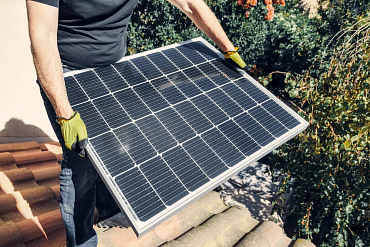What if we covered all the world's roofs with photovoltaics? The planet would cool down, scientists say.
Researchers have analyzed the environmental impacts of a widespread installation of rooftop solar panels.

Could global warming be stopped or reversed if traditional fossil fuel energy sources were completely replaced by solar panels? This theoretical question was addressed in a recent study by an interdisciplinary team of scientists from several institutions in China, Singapore, and the USA. In the study, published in the journal Nature Climate Change, the authors described how they first calculated the global rooftop area using various tools and then calculated how much electricity could be generated if all the world's roofs were covered with photovoltaics. Finally, they examined what overall impact such a change could have on the planet, finding that if solar energy globally replaced fossil fuel energy, the Earth's surface temperature could decrease by more than a tenth of a degree Celsius.
They mapped the global rooftop area
The international research group decided to explore the maximum potential of rooftop solar panels, thus working with a scenario in which all the world's roofs would be covered with photovoltaic cells. To this end, the scientists first calculated the global rooftop area, which they accomplished using various tools, including deep learning of geospatial data and artificial intelligence applications. They mapped roofs at a resolution with an accuracy of one kilometer and concluded that there are approximately 286,393 km² of roofs on Earth today, with 30% of the total area located in East Asia and 12% in North America. At the individual country level, the most roofs are located in China, totaling 74,426 km², followed by the USA with 30,928 km², and India with 23,087 km².
They considered the intensity of solar radiation
After the initial area calculation, the researchers in the next step of the analysis considered the problems associated with electricity generation using solar cells, which are related to various factors such as weather, distance from the equator, and the level of wealth in a given region of the world. The study also included the fact that not all roofs are suitable for photovoltaic installation due to their orientation to the sun, slope, or shading from surrounding buildings. The energy production capacity of rooftop solar panels largely depends on the intensity of solar radiation, and from this perspective, Africa has the most advantageous position, although it accounts for only 7% of the total global installation potential for rooftop photovoltaics. Conversely, macro-regions such as North America, Northern Europe, Western Europe, and Eastern Europe have lower solar radiation intensity, but their installation potential reaches 4.34 TW, which is 25% of the global rooftop photovoltaic potential.
Solar panels could cool the planet
Subsequently, the scientists grouped individual countries into several clusters and calculated the amount of energy that solar panels could generate in each of them. They found that if photovoltaics were installed on all suitable roofs, 19,500 terawatt-hours of electricity could be generated annually. If suitable electricity storage and demand management solutions were available, this could cover most of the current global energy consumption from fossil fuels. Finally, the scientists were interested in how much carbon dioxide emissions would decrease with the transition to solar energy, and based on this value, they calculated the potential global decrease in surface temperature. They concluded that if solar panels were installed on every roof in the world, the Earth's surface temperature could decrease by up to 0.13 °C by 2050. The research team acknowledges that this is a hypothetical scenario, as covering all the world's roofs with solar panels would be very complex. Nevertheless, they note that the new study shows that reversing the progress of global warming is not impossible and highlights the role of solar energy in efforts to mitigate the impacts of climate change.
Source: www.energie-portal.sk
